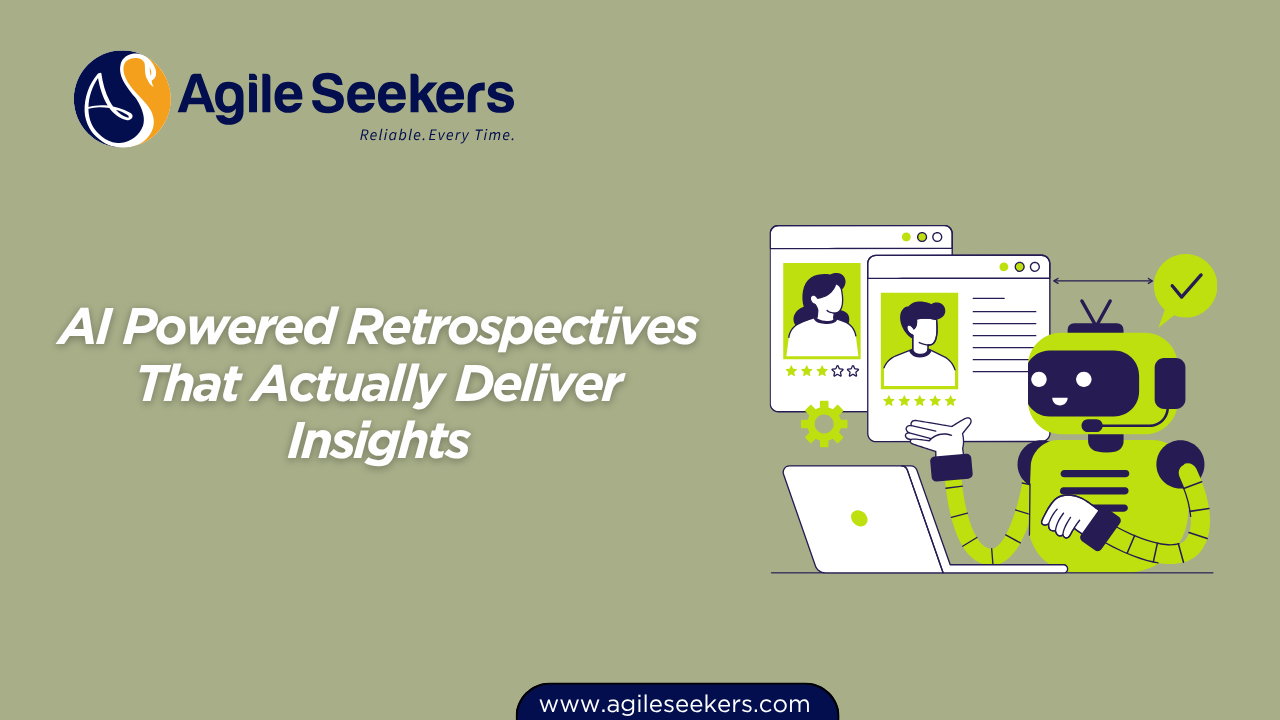AI Powered Retrospectives That Actually Deliver Insights

Agile retrospectives are meant to drive learning and improvement. But let’s be honest—most teams treat them as routine checkboxes. You gather feedback, toss sticky notes on a board, discuss for 45 minutes, then move on. Next sprint? Same issues resurface. No real insights. No data-backed action.
This is where AI changes the game.
Let’s break down how AI-powered retrospectives can actually lead to better outcomes—not just for Scrum Masters and Agile Coaches, but for entire teams and organizations that are tired of guesswork.
The Problem with Traditional Retrospectives
Before diving into AI, let’s talk about what’s broken.
-
Subjectivity overload: Retrospectives often rely on anecdotal memory or whoever talks loudest.
-
Lack of data: Most teams don’t have structured data to back up their feelings about what went wrong or right.
-
Repetitive issues: Without pattern recognition, recurring blockers and behaviors slip through unnoticed.
-
No follow-through: Action items are documented, maybe assigned, but rarely tracked to resolution with metrics.
Sound familiar?
What AI-Powered Retrospectives Actually Do Differently
AI doesn’t just automate—it amplifies. Here's how AI-enabled tools shift retros from reflection to real insight:
1. Turn Team Sentiment into Actionable Data
AI can analyze comments, feedback, and chat logs from team members across retrospectives. Natural Language Processing (NLP) picks up trends in language—like rising frustration around backlog quality or dependencies.
Example:
-
Traditional retrospective note: “We had some blockers.”
-
AI-powered insight: “Mentions of 'dependency', 'waiting', and 'blocked' increased by 45% compared to last sprint. Root cause: external API delay.”
2. Track Patterns Over Time
AI looks beyond one sprint. It spots recurring themes and connects the dots across retrospectives:
-
Are certain teams always reporting missed sprint goals?
-
Are delays often related to deployment issues?
-
Is one role consistently reporting friction?
This pattern recognition is exactly what most Scrum Masters struggle to do manually.
3. Correlate Metrics with Feedback
What’s better than hearing “velocity dipped”? Understanding why it dipped. AI can correlate drop in velocity with sentiment data, story point accuracy, or burndown anomalies.
If teams complain about scope creep and you see a spike in story re-estimation mid-sprint, AI links those dots—fast.
This kind of insight is central to the AI for Scrum Masters Training offered by AgileSeekers. The training helps Scrum Masters actually use AI data to make smarter retrospective decisions.
4. Prioritize Retrospective Action Items with AI Scoring
Let’s say a team has five action items from the last retro. How do you know which one to prioritize?
AI can score them based on:
-
Impact prediction (via historical data)
-
Frequency of related issues
-
Cross-team dependencies
Now your team isn’t just working through a list—they’re tackling the most valuable changes first.
Real Use Case: An AI-Powered Retrospective in Action
Let’s walk through a sprint-end retro using an AI tool:
-
Data Collection: AI pulls in data from Jira, Slack, Confluence, and Git commits.
-
Team Feedback: Each team member fills a quick feedback form—plain language answers.
-
Sentiment & Issue Analysis: AI parses tone, keywords, and flags risk areas.
-
Trend Mapping: Shows a timeline of past issues and whether they’ve been resolved or are worsening.
-
Action Suggestions: Based on the findings, AI recommends top 3 changes to make, complete with impact scores.
-
Follow-through Tracker: These changes are turned into tasks in your backlog, linked with metrics for tracking.
Instead of guesswork, you’re driving improvement with data.
Integrating AI into Your Retros: What You Need
AI isn’t magic. If you want your retros to evolve, here’s what you need:
-
Connected systems: Jira, Slack, Git—your AI tool needs this data.
-
Consistent feedback: Teams need to log honest feedback every sprint.
-
Right tooling: Tools like Parabol AI, TeamRetro with AI assist, or Jellyfish offer AI features designed for Agile teams.
-
Training: Teams need to understand how to interpret and apply insights—not just consume charts.
AgileSeekers’ AI-Driven Sprint Planning for Scrum Masters goes deeper into how AI enhances not just retros, but the entire sprint workflow—starting from planning and estimation to review and improvement.
What AI Can’t (and Shouldn’t) Replace
AI is an amplifier—not a replacement—for real team dialogue. It doesn’t replace:
-
Psychological safety
-
Active listening
-
Human intuition
-
Culture of improvement
You still need retrospectives where people feel safe to speak. AI helps you see what’s going unsaid—but it’s up to you to act on it.
How Scrum Masters Should Rethink Their Role
With AI in the mix, the Scrum Master’s role shifts from facilitator to insight navigator. That means:
-
Asking better questions rooted in data
-
Connecting feedback loops with real metrics
-
Helping teams focus on meaningful improvement, not just surface-level talk
And it’s why training around AI in Agile contexts is no longer optional. It’s a competitive edge.
Final Thoughts: Retros That Drive Results
Here’s the thing—if your retros aren’t evolving, your team probably isn’t either.
AI won’t magically fix team dynamics or cultural issues. But it will give you better visibility into what’s really going on, and surface insights that would otherwise get buried in post-it notes and vague comments.
And if you’re serious about bringing this into your teams, don’t just rely on tools—get trained. Start with the AI for Scrum Masters Training to build the foundational skills, then explore AI-Driven Sprint Planning to integrate AI across your Agile lifecycle.
Because the future of retrospectives isn’t just digital. It’s intelligent.
Also read - Top AI Tools Every Scrum Master Should Explore
Also see - What Scrum Masters Need to Know About AI Based Backlog Refinement




















